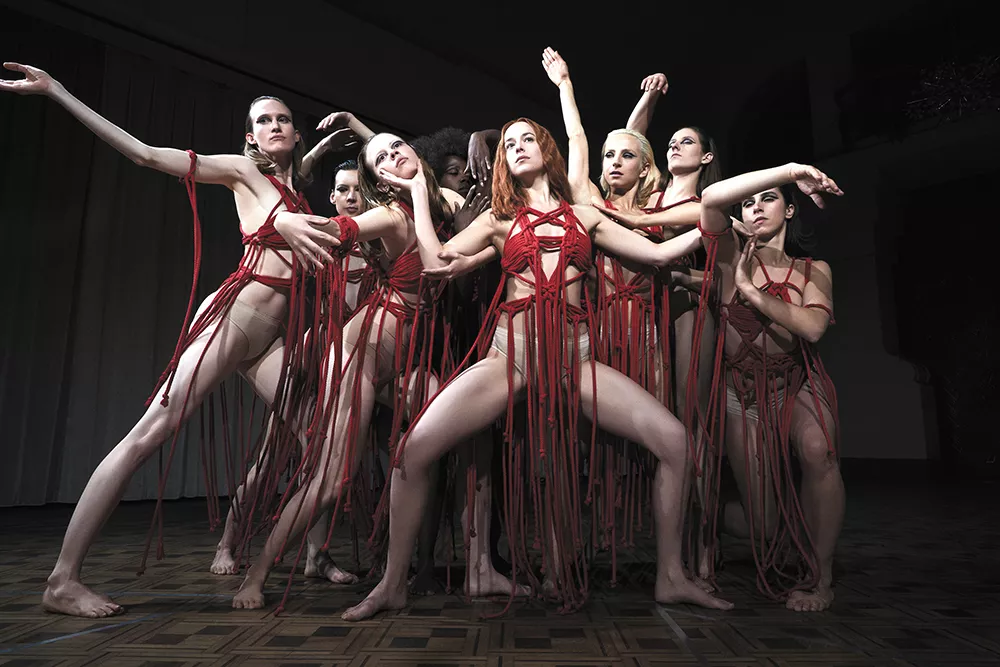Luca Guadagnino's reimagining of Suspiria is the stylistic inverse of Dario Argento's 1977 original. Argento's film, told with the lean simplicity of a fairy tale, revelled in bold primary colors and seemed to exist outside time and space. It's sublime madness, the pinnacle of Italian horror, and its goriest moments are also some of its most beautiful.
This new Suspiria, meanwhile, is a sprawling, unwieldy, 152-minute ordeal, grounded in the grim realities of European genocide and fascism, with an ashen visual palette of concrete, fog, dried blood, decaying flesh and exposed bone. It has been a dream project for Guadagnino (Call Me by Your Name), who has said he reveres the source material, but his interpretation feels less like tribute than repudiation, a horror movie made by somebody who doesn't really seem to like horror movies all that much. He's referred to it as a "cover version," but the melody, tempo, key signature and most of the lyrics are totally different.
So maybe it's unfair to compare the two, since all they really share is a very basic premise, but then maybe it was a mistake to call this film Suspiria in the first place. Even if you're walking into it cold, though, you'll likely be wondering how so much stuff can add up to so little.
It's set in 1977, the same year Argento's film was released. An American named Susie Bannion (Dakota Johnson), having fled from a devout Mennonite family, arrives at a Berlin dance academy, which is presided over by the severe but ethereal Madame Blanc (Tilda Swinton). Susie rises in the ranks in the academy almost immediately, catching Blanc's eye and replacing the lead dancer in the school's upcoming production.
And then there's a string of mysterious disappearances and gruesome deaths, and wouldn't you know it — the school is run by a triad of powerful witches that will cruelly dispatch anyone who doesn't fall into line.
The film then builds and builds and builds to a finale that could be praised as a feat of bloody excess were it not so hilariously dumb. There are geysers of gore and graphic disembowelments and exploding heads, rendered in laughable CGI while Thom Yorke warbles on the soundtrack (though most of his musical score, the first he's written, is used to terrific effect). It's a stab at transgression that really misses its mark.
Haunting the whole movie are the ghosts of Germany's past. The dance academy is a stone's throw away from the Berlin Wall. Radio and TV reports detailing terrorist attacks are constantly humming in the background. There are earnest discussions of the Baader-Meinhof group. On the fringes of the story is an elderly psychologist (credited to "Lutz Ebersdorf," which is really Swinton in truly impressive makeup) who's investigating the suspicious goings-on, all while prodding at the wounds of his wife's death in a concentration camp. (In flashbacks, she's played fittingly by Jessica Harper, star of the original Suspiria.)
It's these new elements that betray the film's true intentions, I think, and they feed a tired narrative that suggests horror movies can only be Important or Worthy if they're also weighed down by heavy, real-world subtext. Guadagnino and screenwriter David Kajganich have taken a perfectly good premise and molded it into some kind of tortured thesis on generational guilt, the perils of motherhood and the cultural and emotional stains of genocide, and it is, frankly, a load of bullshit.
But what of the good elements in Suspiria? Dakota Johnson (who also appeared in Guadagnino's underrated A Bigger Splash) continues to be an intriguing screen presence, and any movie that casts Tilda Swinton in multiple roles (see if you can spot the third character she plays) can't be all bad. The dance sequences (choreographed by Damien Jalet) are entrancing and beautiful, and cinematographer Sayombhu Mukdeeprom lends them a feverish, dizzying quality. And the movie's one truly horrifying set piece, in which the dancer Susie replaces is sent into a limb-twisting fit, is stunning in how it marries the lithe, muscular movements of ballet with bone-crunching brutality.
That sequence also sums up Suspiria as well as anything: Guadagnino's attempt to escape the shadow of the artist he has supplanted involves him contorting and stretching a genre classic into something else entirely — a ponderous, mostly empty dissection of said genre classic. It has moments of brilliance, and even more moments of flagrant stupidity, and it's all so self-serious that I just couldn't take it seriously at all. Your mileage may vary. ♦

